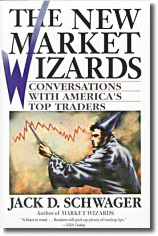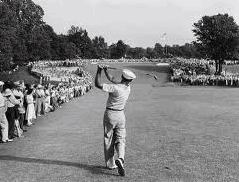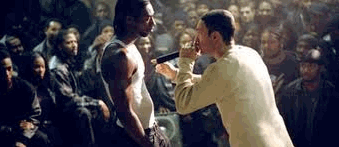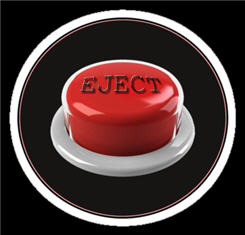Are You Willing to Lose, Part 1
June 1, 2011 at 11:26 am
 In Jack Schwager’s classic The New Market Wizards, Mark Ritchie delivers a very simple but profound statement on the subject of losing:
In Jack Schwager’s classic The New Market Wizards, Mark Ritchie delivers a very simple but profound statement on the subject of losing:
“…I don’t think you can make money unless you’re willing to lose it…my willingness to lose is fundamental to my ability to make money in the markets.”
Losing is a part of trading, there’s no getting around it and everyone does it…but not the same way. The best traders lose like a winner.
Too many traders fear losing, and to be honest I’m often guilty of it too. Sometimes it’s a healthy fear and at other times a limiting fear, so it’s an ongoing issue each of us face.
The wrong kind of fear keeps us on our heels. It might cause us to dart out of good trades too quickly, cutting the legs off our winning trades (get it, so they can’t run?). Or it may leave us sidelined, unwilling to participate even when we sense the presence of opportunity. Sometimes we respond to our fear by trading too small, or simply by becoming far too stressed over trades which are small enough to be insignificant.
For example, you know that when you’re trading small enough that a trade’s outcome (win or lose) will result in virtually no change in your account value, and yet you’re fretting over it, it’s a clear signal that your fear is too great and you’re in no shape to be trading until you get a handle on it. I can say that because I’m familiar with the feeling!
Your Trading, Defined
The title of this post isn’t “Do You Want to Lose?” It’s “Are You Willing to Lose?” There’s a big difference, so let me be clear. This isn’t an approach where we face the markets each day hoping to shrink our account. Rather, it’s a mindset whereby we play only with that which we’re able to lose, and nothing more. It’s a mentality where we trade in such a way that we evaluate our risk, do our best to contain it, and then move forward boldly. We aren’t held back by worry over what might happen.
Tomorrow we’ll wrap this up with Part 2, but until then, let me give you a question to consider:
How would you characterize your own approach…are you defined more by your confidence or by your anxiety?
Trade Like a Bandit!
Jeff White
Producer of The Bandit Broadcast
Practice Winning
May 31, 2011 at 9:57 am
In my office hanging on the wall, I have a whiteboard, a plasma TV, some handwritten wisdom my grandfather penned in 1973, artwork from my 3-year old, and a Kenny Rogers poster. A bit random, yes.
Right alongside those things, however, is a large photo of Ben Hogan’s 1-iron approach to the 18th green in the final round of the 1950 U.S. Open at Merion. It set up a 2-putt par to put Hogan in a playoff the following day, which he won for his fourth major title. It’s black and white – which is classic – just like the moment it captures.

Preparation + Confidence = Performance
When I stare at the photo, I’m most impressed by Hogan’s focus. Perhaps the first thing you notice about this famous picture is the gallery lining the entire scene. Thousands had spent their day following him, and with the finish imminent, they stood silent, awaiting the outcome. And with history on the line, Hogan hit a masterful shot – just as he had practiced countless times – as if he weren’t nervous.
But he was human – and nervous indeed. He knew what was on the line. His confidence and preparation simply suppressed the effects of his nerves, so that he could perform his craft and execute with precision the same shot he’d hit many times in solitude.
It didn’t matter that he had to make par. It didn’t matter that he had to hit arguably the hardest shot in golf – fading a 1-iron against a right-to-left wind so the ball would land softer on crusty U.S. Open greens. And it didn’t matter that he was likely exhausted from walking 72 holes on legs which had been battered so badly in a near-fatal car accident just a year prior.
What mattered to Hogan was wrapping himself up in the process, ignoring the buzz around him, forgetting (if not thriving on) the pressure he faced, and relying on his preparation – both physical and mental – in order to produce a great result with controlled emotion.
Repetition is the Mother of Skill
Whether it’s sports or music or any other craft – including trading – there’s no substitute for preparation and practice. Hitting golf balls on the driving range can produce the “muscle memory” needed to groove a golf swing. Standing in the gym and shooting free throws every day will make you better. Watching the order flow, working the charts, and making trades on a regular basis will both train your eye and develop the gut feel you need as a trader. And such things must be done by those who want to get good.
But for those who want to be great, that’s not where it stops.
Both your skills and your mental game must be improved.
 When it comes to skills, you have to hone your existing skills and tighten up any loose ends. Tighten your routine, and increase your discipline with what you know. But you must also build your cache of talents. Learn to operate on other timeframes. Get better at evaluating risk, managing money, and overcoming biases. Become more efficient by learning when to add to winning trades, hop on board existing trends, identify reversals, trade news, and execute with precision. Not surprisingly, these are the same skills which are taught in the Advanced Trading Course.
When it comes to skills, you have to hone your existing skills and tighten up any loose ends. Tighten your routine, and increase your discipline with what you know. But you must also build your cache of talents. Learn to operate on other timeframes. Get better at evaluating risk, managing money, and overcoming biases. Become more efficient by learning when to add to winning trades, hop on board existing trends, identify reversals, trade news, and execute with precision. Not surprisingly, these are the same skills which are taught in the Advanced Trading Course.
Beyond those things, your mental game cannot be ignored. Visualizing literally everything and mentally rehearsing situations and emotions is another key component. Hogan practiced for repetition, but he also practiced with purpose, picturing situations where he’d need to pull off a shot under pressure or with potential distractions.
You must do the same. Make the time every day to take a break and shut everything down around you. Make a list for yourself of situations you might face in your trading, whether a string of losses or wins, or monitoring multiple positions, or the urge to trade when nothing is setting up, or feeling left behind in a market move. Take them one at a time, and imagine what you will do and how you’ll respond.
Picture yourself in control, not in a way that everything does what you want, but in such a way that you’re not feeling panic or fear or distraction from your trading process. Imagine the intensity of each situation having the opposite effect by actually increasing your focus. Starting off, it may just be a couple of minutes, but as you practice and become more skilled at visualizing, you will add more time. And you’ll be amazed what follows.
As you think about your trading, are you able to approach big situations with supreme confidence? Do you need to know more or improve your techniques or get better equipment or become mentally tougher? Then what are you waiting for?
Trade Like a Bandit!
Jeff White
Producer of The Bandit Broadcast
Walk the Line
May 27, 2011 at 10:41 am
 Trading is all about opportunities. Every day is filled with chances to ride a rally, short a selloff, or sit on the sidelines to protect your capital.
Trading is all about opportunities. Every day is filled with chances to ride a rally, short a selloff, or sit on the sidelines to protect your capital.
But there’s a very fine line to walk between having a fear or respect for what the market can take from you, and having the boldness and confidence to take a risk and get paid.
There are several keys to walking that line successfully, such as:
- Having the necessary capital to participate.
- Building and maintaining sufficient skills, methodology, and a game plan that produces consistency.
- Discipline and readiness to move swiftly when it’s time to act.
- The mental restraint not to let your mind race too far ahead.
That last bullet is arguably more important than the others (although each are necessary), so let’s dig a bit deeper into it. When I say don’t let your mind race too far ahead, I’m not referring to the productive foresight of anticipating a move – that’s fine. Rather, I’m referring to thinking habits whereby you’re focused on things which are not a present-tense reality.
These are the thoughts that have you counting on a gain before you’ve actually booked it, or fearfully racing for the exit at the first sign of your trade’s hesitation. They’re destructive and damaging thought patterns, and they aren’t “on the line” we want to be walking.
In your trading, do you allow your mind to get ahead? Are you able to stay objective? It’s an issue of self-control, and it absolutely impacts your trading results.
I’d love to give you a simple 3-step process to entirely eliminate any lack of discipline in your thought process, but the truth is it takes work. It can’t be rushed. Even your thought patterns are based upon habit.
Final word: commit to making some good decisions every day – no matter how small – knowing it’ll keep you right in the sweet spot between respecting the market and confident execution.
Trade Like a Bandit!
Jeff White
Producer of The Bandit Broadcast
Flip Your Fears
May 26, 2011 at 9:17 am

“Look…if you had one shot, or one opportunity … to seize everything you ever wanted in one moment…would you capture it, or just let it slip?”
Pivot Points to Watch 5-25-2011
May 25, 2011 at 12:42 pm
Working the charts today, I’m seeing a ton of stocks sitting just beneath descending trend lines, all of which are potential pivots for bullish moves.
In the video below, I take 5 minutes to run through a couple dozen setups to keep an eye on, highlighting the setups and pivot levels to take note of.
Thanks for joining me for today’s video, until next time…
Trade Like a Bandit!
Jeff White
Producer of The Bandit Broadcast
Not a Pattern Day Trader?
May 24, 2011 at 10:19 am
The phrase ‘Pattern Day Trader’ has this negative connotation to it which scares a lot of people unnecessarily. It conjures up images of high risk or compulsive behavior, neither of which are entirely accurate.
Many traders have asked me about having the Pattern Day Trader designation out of concern that it puts them in the same light as ‘perpetual liar,’ or ‘drug addict’ or any of the corrupt individuals found on the no-fly list.
Nonsense! Don’t get spooked by a label.
 The Pattern Day Trader designation is simply a category for an account, and therefore doesn’t mean you have any sort of a repetitive disorder!
The Pattern Day Trader designation is simply a category for an account, and therefore doesn’t mean you have any sort of a repetitive disorder!
What It Is
The SEC implemented this classification for accounts, and brokers are required to comply. The restrictions imposed on those without the designation are not a plot against you – your broker is simply enforcing what they’re required to do. Supposedly, the SEC put the PDT rules into effect to protect those with smaller accounts from the ‘high risks’ associated with day trading (as opposed to those ‘other’ high risks found in longer-term ‘investments’ or crossing the street at a busy intersection).
* Personally, I think attempting to pick the next MSFT and holding
hoping for decades it works out is higher risk than the astute day
trader who’s continually limiting his losses, but I digress…
The Pattern Day Trader distinction carries with it two requirements, which are that the account is a margin account, and that it maintains a $25,000 equity balance. Once those are met, you’re free to trade as often as you want, as well as have the benefit of 4:1 intraday margin at your disposal – nice for those who know how to use it.
Those without this account designation, however, have some restrictions. Primarily, they’re unable to make 4 or more round-trip trades in a 5-day period. That really cramps the style of the would-be active trader who has an account below the threshold, and it’s easy to argue that there’s HUGE risk in having your account frozen when the market is on the move.
Get Creative
If you’re one of the traders currently limited in your activity by the Pattern Day Trader restrictions, take heart. You have choices.
The most obvious is to fund your account enough to bring it past the threshold. That’s not an option for everyone, but arguably, even if you didn’t intend to fully utilize the capacity of the account (or day trading buying power which comes along with it), you’re at least free to trade as you see fit with no restrictions.
Supposing that’s not a viable option, there are others, so let’s explore a couple.
* Focus on longer timeframes. There’s nothing that says you can’t trade – only that you can’t trade very frequently! That shouldn’t prevent you from zooming out a bit on your timeframe from multi-hour trades to multi-day trades, ie: swing trading. That approach certainly has benefits – not only does it allow you to sidestep much of the intraday noise and seek out larger moves, but it will of course mean fewer transactions. The lack of churning will also cut down on commissions, which is a nice fringe benefit.
* Consider trading futures. Futures are leveraged, but for the e-mini Nasdaq 100 or S&P 500 futures contracts, margin requirements are pretty low. Futures are also not restricted to the Pattern Day Trader, so activity isn’t limited.
* Look at your options. While the Pattern Day Trader rule still applies to options, one element which many don’t consider is the turnover of capital within smaller accounts to make room for a new equity position. For example, if you’re holding a stock which you don’t necessarily want to dump, yet see another you’d rather have, most likely you’ll exit the old in favor of the new (supposing your account doesn’t have enough equity to hold them both). With options, however, smaller amounts of capital are needed to control an equity position, thus allowing you to have positions in both. Options of course expire, and there are other risk factors to consider if you have no experience trading them, but they do offer an alternative to an either-or equity stance.
The bottom line is that even if you’ve been slapped with the Pattern Day Trader designation, there are ways to be effective without simply buying and hoping. As in many endeavors, a little creativity goes a long way in trading.
Trade Like a Bandit!
Jeff White
Producer of The Bandit Broadcast
Are you following me on Twitter yet?
Premature Evacuation from Trades
May 23, 2011 at 10:10 am
 All of us have the occasional urge to jump ship early from a trade, but when is it the right time and how should that be done?
All of us have the occasional urge to jump ship early from a trade, but when is it the right time and how should that be done?
Let’s take a look at a conversation I recently had with a trader I was helping…
Hey Jeff,
I’m long ***, as it just looked like a nice setup. I went long 4 days ago, but it is behaving horribly. Currently I don’t see any pattern and would not make this trade now, but it is only halfway to my stop loss. I am unsure what to do. How do you approach trades you aren’t convinced of anymore, but have not been stopped out of?
Also, one of the mantras I read often is “cut losses short, let winners ride.” I am wondering how to interpret this “cut losses?” I find myself thinking, “I am not convinced in this trade anymore, but maybe it will turn around, it’s just half a position left to lose.” When my analysis of the situation shifts, and I wouldn’t take this trade anymore as of today, do I abandon my original plan and exit immediately or should I stay with the trade?
C.
==
Here’s what I told him…
C,
Let me start off by addressing the “cut losses short” question. I don’t have all the answers, but I can tell you that for me, cutting losses means having an exit plan on the downside with defined risks. We will all be wrong at times, but staying wrong is different – don’t stay wrong! Limit your losses so that they can be overcome with reasonable winning trades. Don’t dig a hole so deep you need a miracle to get out – that’s cutting your losses short.
Now let’s discuss early exits on trades like this where your conviction level has changed…
Occasionally you’ll find trades like this which don’t completely fail (stop you out), yet don’t work either (move to your targets). Instead, they just begin to stagnate and enter into a trading range where your funds are tied up. It can be a bit frustrating, simply because you’re left in limbo, wondering if the trade is in the process of failing or working. Each new red or green bar feels like the start of something meaningful, but they’re followed by the opposing color and you soon realize that price is simply showing indecision.
A key consideration to make when this happens is whether the character of the stock has changed. Stated otherwise, do you have a good reason to now lack conviction, or is it merely a mood shift for you?
A slow-moving trade is far different than one which may have just experienced an important technical event…
- Just because a trade isn’t developing quite as quickly as you would have wanted doesn’t mean it’s destined for failure.
- The stock may be building a new pattern which you simply haven’t identified yet.
- When I find myself in a trade which is starting to bore me, I know I’m overanalyzing when I start looking for signals which aren’t there.
- If I’m positioned in accordance with the overall market (ie: long in a market uptrend), and if my trading capacity isn’t restricted because of this position (I don’t need to free up capital), then what I need to do is stay with the trade until a technical reason prompts an exit. I likely need to stay patient, as this is still a trade which can pay me.
On the other hand, there are times when a premature exit may be warranted…
- When the stock has just seen a change in character as measured by a technical event (high-volume reversal, for example), an adjustment may be called for.
- If your trading funds are limited and you’d rather shift into a better idea, then you might consider closing out the trade in favor of another with more promise.
- When you find yourself positioned in opposition to the prevailing market trend (ie: long in a market downtrend), then you have grounds to at least lighten up. That can be done either by reducing your position while maintaining your original stop & target parameters for the trade, or by tightening both your risk and objective.
What else could help C. in this situation?
Trade Like a Bandit!
Jeff White
Producer of The Bandit Broadcast
Are you following me on Twitter yet?





